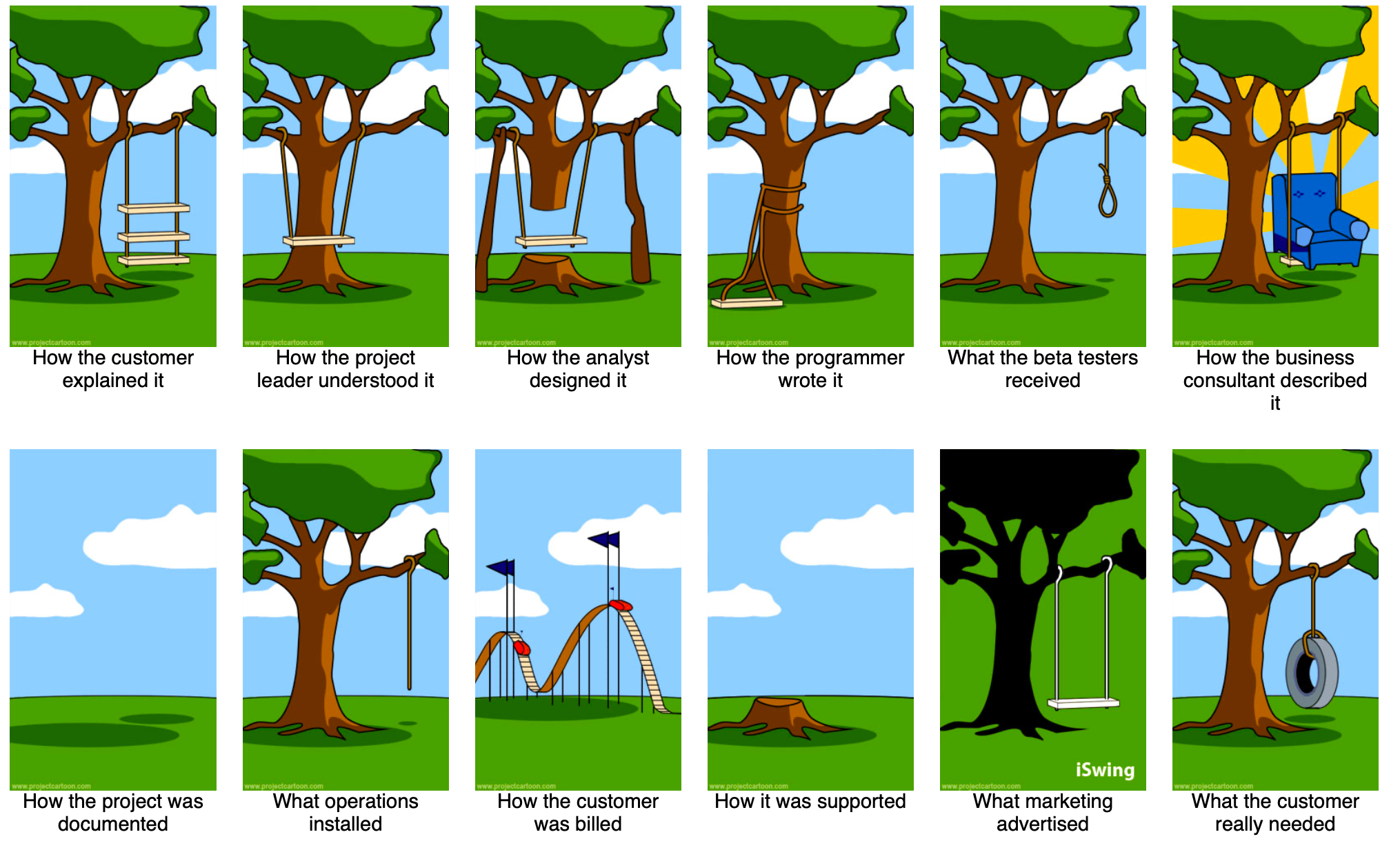For every leader, there’s value in being a doer. Being a doer often means working on the front lines of your organization where most of the action happens. This work should be combined with making important decisions from the top at the executive level. Leaders who can work in the trenches while also making strong decisions for the company are essential for business success. Only with that range can a leader be at the forefront of making all the vast amounts of daily work truly align with what the customer expects.

The above image is hilarious because it underscores both why it’s so hard to deliver great solutions and how every role in the company is in on the joke. A leader can help eliminate this misalignment in an organization by using range to gain an understanding of the perspective of each team.
Delegating Is Not Enough
Everyone is responsible every day for what they do — delegating tasks to other people does not count as “doing” anything. Leaders must manage their enterprises, of course, but time spent managing should be minimized to reserve time and energy to do things that help the enterprise and to be interested in other people’s work on the same objectives.
Building culture in an organization is an important part of any executive’s job, but you should do more than just pat a worker on the back and give a quick verbal compliment. You should be going to the employee and saying, “Show me your screen and let’s work on this together right now.” This enables you to learn, coach, and make sure that every detail lines up with the overall objective of your company. Cracking a small problem with a small team sets an example that helps the organization get better faster.
Range Lets You Get Deep Into the Work
Everything you do at work has to line up. For leaders who join a team, it’s of utmost importance to dive deep and fully learn the product, clients, and business in order to lead successfully. Without range, leaders go into teams and remain on a surface level. They never get into the weeds of the work. In teams like that, when you look back at what was accomplished over a few years and lots of money spent, it’s usually hard to see what was delivered.
The great products of the world, such as the iPhone and Tesla, were created by leaders who were deeply involved and even obsessed with their product’s every detail. The behavior of those huge leaders at the top became commonplace across their organizations – meaning thousands of people worked together in networks of small teams with work that had to line up. This kind of teamwork is more like working on the Panama Canal, D-Day, or a major motion picture than working in “operations” or “consulting.”
You can see this in the military, too. Successful leaders drive overall strategy but also check how many bullets each person is carrying. Then, they redesign a sub-process in the long supply line. They are highly invested in the objective and therefore every process.
Investment Leads to Better Outcomes
Startups have an 8% chance of success. This is a very slim number, and it shows that being the right kind of leader can be hard. It takes leadership with range to make something succeed. It’s insufficient to say, “I want a product that makes hospitals more efficient.” An idea is not enough to make a difference for a user. There are thousands of questions that need to be answered to bring the idea to life.
When teams don’t have leaders who show range, staff members usually become disengaged. Employees immediately sense whether or not their boss is interested in their work. If managers aren’t interested, why should employees be? Employees will then have a lack of direction and motivation, which leads to poor alignment. True alignment means that everyone is on board and rowing in the same direction. Without this, companies waste time and money.
Having Range Requires Confidence, Courage, and Humility
It takes courage to be vulnerable and step down from the leadership ladder to work on the front lines alongside your employees. Humility is required not only when you’re talking to someone on your team and showing interest in their work but also when admitting to them that you don’t know the technicalities of what they do. It involves making the conversation centered not on you but on others.
Think of It As Being Multilingual
I tell my new hires they need to become “bilingual” in hospital operations and software engineering so they can engage deeply with both clients and the engineers who build our products. After gaining different fluencies, they become “multilingual” with knowledge of operations, software development, user experience, financials, people development, strategic planning, and so on.
I once was on a call with different team members trying to figure out how to measure the accuracy of a machine-learning forecast algorithm for patient discharges. It was complicated because we received a new forecast for every patient, unit, and level of consciousness every hour, and patients had various diagnoses that required different resources and time commitments. The team members were frustrated because they each saw only a small part of the bigger picture from all the data. After hearing these frustrations, the next call I joined dealt with the three-year roadmap of our flagship product, Patient Manager, to help eliminate the concerns. This showed me just how critical it is to understand things from the perspectives of various employees because these perspectives will better inform the decisions you make at the executive level. So many leaders are so good at this, and that’s why their businesses are more successful and their teams are happier.
When you deeply understand your team’s work and your customers’ context, you know the next moves to make. By exercising range, you can consider your customers’ full experience and needs and the capabilities and dynamics across your organization. You can make commitments and lead with purpose to ensure all these commitments are met. This leads to happier employees who feel more comfortable working alongside you and each other rather than just for the organization, which will ultimately result in greater success for your clients. Only when you’re consistently delivering success for your clients does management enter the equation so you can get that success to your shareholders.


